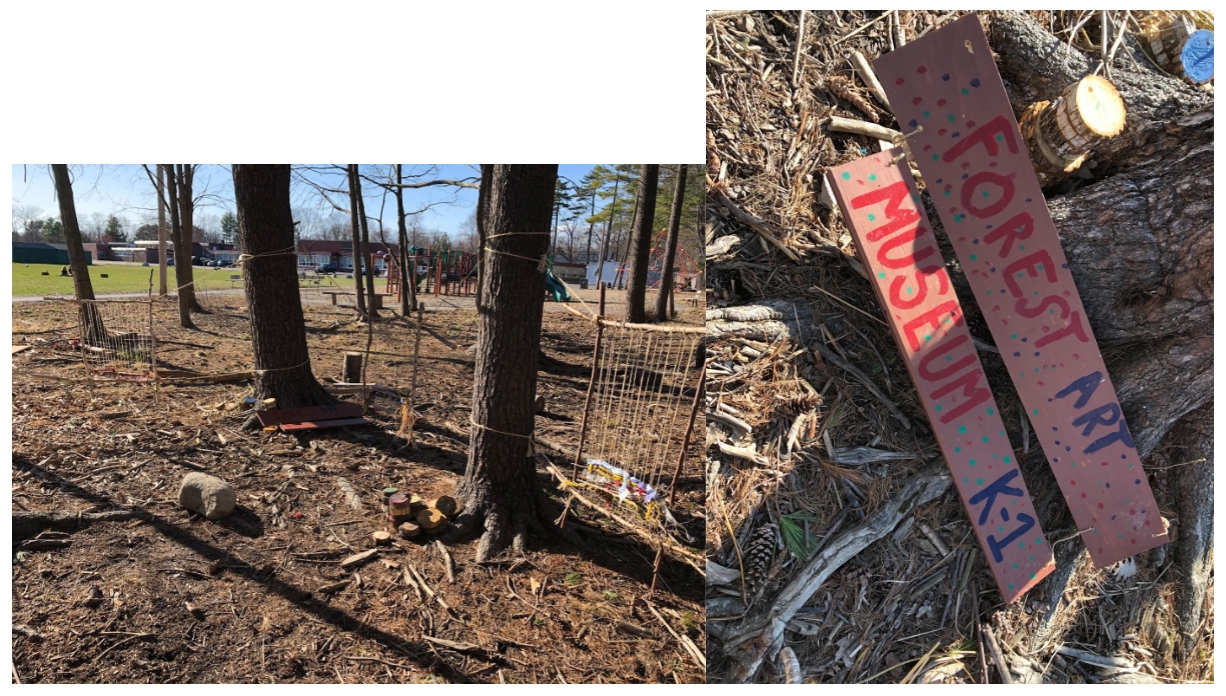
Few of us would argue that engaging students in the arts — visual, music, dance — is an important part of school. It’s well documented that arts engagement supports academic and social development, but with competing demands on time and budgets, enrichment in visual arts, music, and dance, historically has taken a secondary seat.
So, as the parent of two elementary-aged daughters enrolled at our neighborhood school, I was pleasantly surprised this fall when my youngest daughter brought home her first kindergarten art project. “You made this?” I asked, as I flipped through a hand-constructed book. Clearly the result of days of work, it was tied with twine and a spine fortified with sticks. In each of the ten pages she’d illustrated different animals next to their corresponding track prints. “Yeah, mom,” she chirped. “We made it OUTSIDE!” (It was November in Maine. And, yes, it had already been snowing.)
Our family’s experience with “forest art” was just one small part of the school’s plan to navigate COVID-19. The “where” of learning has changed alongside the “when” and “how.” In addition to working in different spaces, our kiddos were also working for longer with the same teachers in smaller cohorts. Once-a-week music class has now turned into multiple-days-a week learning on the same instrument (xylophones).

Image: Forest art at the author’s childrens’ school, Lyseth Elementary School in Portland Maine.
As part of a forthcoming research project with the education nonprofit I head, I’ve been talking to leaders across 20 public school districts to learn more about the ways instructional practice has positively changed over the course of the year. Given my own experiences as a parent, I shouldn’t have been surprised that a common theme in these conversations is the way in which COVID-19 has forced communities to rethink structures for arts enrichment. Here are three bright spots I heard emerge:
Deeper, sustained work. Given the need to create contained pods and limit outside contacts, many schools, like mine, had to rethink how and when arts teachers would work with students. A number of the schools we spoke to moved away from the “once a week” model of enrichment to having arts specialists work over a sustained duration with a set of students for weeks at a time (often three to six, on a daily or every-other-day basis). Doubling the time with kids, week over week, has allowed these teachers to develop a depth of relationship with students they’d never had before.
More importantly, the work students completed was much more sustained, which allowed them to more deeply develop skills and improve projects — and it shows. As one Wisconsin leader reflected, “The depth of the projects that the students were doing or the depth of the learning that the students had was so much better. Like the art, like if you see the art projects the students did this year, it was incredible.”
Tapping into partner resources. The pandemic disrupted how many arts and other cultural nonprofits delivered, shifting to online for services and collection access. For example, in Austin, changing schedules and remote learning helped push the district and partners to rethink the city’s Creative Learning Initiative. In the past, artists worked mainly with teachers in professional development sessions. Moving online opened up more opportunities to bring these specialists into lessons as part of the online classroom, interacting directly with students.
In addition to tapping into these experts, schools also turned to these organizations to access new materials and curricular resources. Given more ubiquitous access to online materials and devices, many reported using new external collections and activities created by partners.
New places and with new audiences. In many places, arts shifted outside — outside spaces created opportunities to build larger projects and incorporate natural materials. Teachers began to wonder “if we’re going to be outside, what are the elements of the natural setting that we can use to enhance learning?” This creative thinking extended to at-home hybrid learning days too; in one middle school mixed media class, students created snow sculptures and captured them digitally for an assignment.
New spaces also allowed for students to break free of traditional limits like auditorium sizes (or, for many, the lack of an auditorium) to build bigger audiences, performing in new ways. For example, performances in public parks allowed systems like Meriden, CT to dramatically increase the number of people who could attend school plays. In Monterey, CA, students figured out how to broadcast their play’s audio over radio, converting their performance into a drive-in theater. Student performances also went online, such as in Cudahy, WI, where students led a COVID-friendly production of Clue, which streamed far and wide.
Put together, these are just a few examples of ways that COVID-19 has forced educators to think more flexibly about where and how the arts happen in school. For my own kids, it’s been cool to see how access to the arts has helped keep them making connections to adults and their own creativity during a time of disruption and change. From a broader equity standpoint, it’s also powerful to imagine how these bright points offer concrete ways to bring new resources – time, materials, spaces, and expertise – to bear for every student. As we imagine how to move forward from the pandemic, advancing models that are more actively engaging, growth-oriented, and socially connected, will we be brave enough to build from them?

